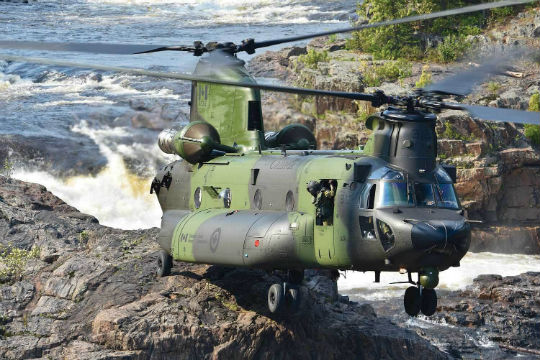
Tactical agility combined with heavy-lift capability makes Canada’s Boeing CH-147 Chinook a formidable asset. Here, the flight engineer serves as the pilot’s eyes during this precision landing on a rocky ledge. Mike Reyno Photos
Nobody seemed surprised except me. “Our gross takeoff weight will be 38,163 pounds,” declared flight engineer MCpl Greg Bullivant. He must have seen the expression on my face. He patiently explained that we were still about eight tons below maximum gross takeoff weight.
By any measure, the Royal Canadian Air Force’s (RCAF’s) new Chinook helicopter is a heavy hauler, but its capabilities go well beyond brute strength. Whether the tasking is for humanitarian assistance, response to natural disasters or support to the army in the field, the brand new Boeing CH-147F is a modern, versatile tactical transport helicopter that can serve a wide variety of missions. That versatility would be in evidence during a hands-on demonstration flight with 450 Tactical Helicopter Squadron at CFB Petawawa, Ont.
Briefing time
“Our” Chinook, CH-147312, was to lead a simulated tactical troop insertion and resupply mission, escorted by two RCAF Bell CH-146 Griffon helicopters. “Wildcat 29” was a Griffon from 438 Squadron in St. Hubert, Que. “Lion 27,” from Petawawa’s 427 Special Operations Squadron, was tasked as the photo ship.
The crew consisted of Capt Brian “Jake” Epp, who is 450 Squadron’s tactical standards officer, as aircraft commander, with myself as the somewhat wide-eyed but very lucky journalist/co-pilot. The “back end” crew consisted of flight engineer MCpl Bullivant, and loadmaster MCpl Mike O’Connell.
Epp thoroughly briefed the assembled crews on the mission objectives, radio frequencies and the navigation route, and patiently explained my presence in an otherwise tidy military formation. Interestingly, the Chinook would easily outrun its escorts, so we planned a join-up en route. We would fly a low-level tactical route “at the speed of heat,” in Epp’s terms, while the Griffons would proceed direct to a rendezvous overhead our target. We would return to base in formation. Upon return, we would perform some slinging to demonstrate the big helicopter’s external cargo airlift capability. It would be an ample demonstration of the Chinook’s repertoire.
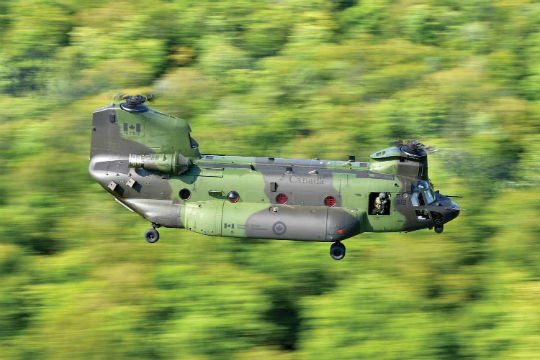
Although tandem-rotor helicopters are exotic beasts, from a pilot’s point of view, a Chinook is still just a helicopter.
RCAF Chinooks, then and now
The RCAF is well acquainted with the Chinook, having operated eight early-model CH-147s with 450 and 447 Squadrons from 1975 until they were retired due to cost-cutting in 1992.
Then came Afghanistan. In 2008, the Manley Report recommended to Parliament that an immediate heavy-lift helicopter capability was essential to the extension of the Canadian mission, and the government subsequently purchased six used U.S. Army CH-47Ds, an interim measure for use in Afghanistan. The need for a sustained tactical heavy lift capability was evident to the military, and in August 2009, Canada signed a contract for 15 new “F model” Chinooks.
The new CH-147Fs began to arrive in Petawawa in June 2013. An impressive 538,000-square-foot (50,000-square-meter) hangar/workshop/training facility awaited the new machines upon their arrival. 450 Squadron has some of the most modern facilities in the RCAF.
450 Squadron is the sole unit responsible for operating the Chinook. It now has its full complement of 15 machines on strength, plus three specialized simulators: a full-motion high-fidelity training simulator, a fixed-base tactical flight training device, and a field-deployable crew training simulator. It speaks to the complexity of both the machine and the mission that air force crews can deploy with their simulator. And, yes, the simulator is painted camouflage green.

The CH-147F Chinook and the CH-146 Griffon work as a team to provide the air force’s tactical helicopter capabilities.
There is also a maintenance training facility — which looks a lot like a partly disassembled Chinook surrounded by scaffolding — and an “integrated gunnery trainer,” which is a simulator for teaching aircrew how to fire weapons from a moving platform. Given the scope of its responsibilities, 450 Squadron is a big unit, with approximately 400 personnel.
Epp explained that the Chinooks currently operate under a “provisional operational airworthiness clearance,” which is arcane air force terminology that means they are still working out how to best employ their complex new beast. Epp described the squadron’s approach as “walk, then run,” explaining that many operational capabilities of the Chinook are yet to be fully implemented. It’s not that the Chinook itself is lacking, but rather that the learning curve is steep in implementing a new machine, and it will take time for all of the Chinook aircrew to train to full operational capability. Safety is on everyone’s mind during times of transition.
Heavy hovering
It was time to go flying, but first Epp offered a guided tour of the cockpit, which is dominated by five 6×8-inch color liquid crystal displays, each of which is surrounded by software-configured “hot keys.” Each pilot had a control display unit (CDU) on the center console, which served as his interface to the mission computer. Epp spent a few minutes entering our fuel and cargo load, following which the computer continuously updated weight and balance and performance data. Our flight plan was loaded from a data card.
The presentation on the primary flight displays seemed cluttered to my eyes, although that was likely the result of the busy tactical data presentations that are not common to civil flight displays. I poked some buttons to familiarize myself with the interface, but quickly realized that some adult supervision would be required. The menu structure seemed complex and deep.
Like many modern flying machines, I expect that “proficiency” in the Chinook is more a matter of familiarity with software syntax than mechanical flying skills. Working the instrument panel is its own skill.
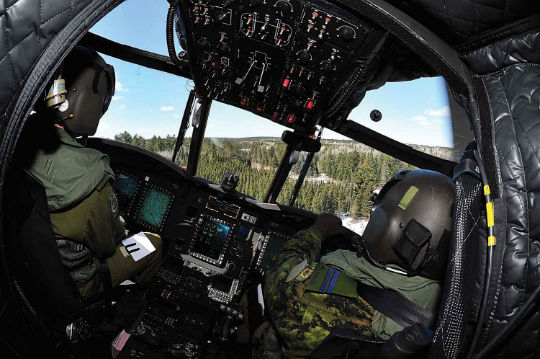
Chinooks have been in production for over five decades, but modern avionics make the RCAF’s Chinooks state-of-the-art.
Start-up of the Chinook took about 15 minutes, although my unqualified presence was something of an impediment. Two qualified pilots could negotiate the checklist a lot faster. We taxied to the helipad, and without fanfare or explanation, Epp directed me to lift the Chinook into the hover. I looked at him. It’s that easy? It is. Almost. Sitting on the ground, application of thrust causes the helicopter to roll forward, so a stationary lift into the hover required application of the brakes, a small amount of aft cyclic, and a gentle pull on the collective — Chinook pilots call it a “thrust lever.” Epp offered me a few minutes to familiarize myself with its handling.
Tandem rotor helicopters are exotic beasts; quite unlike conventional helicopters. The cockpit controls consist of the familiar cyclic, collective and pedals, but the controls are mechanized differently. Left or right cyclic tilts both rotor heads laterally to control roll. Longitudinal cyclic creates pitch changes through differential collective control of the forward and aft rotor heads. Pedal inputs induce heading changes by differential lateral tilt of the forward and aft heads. If it all seems a bit complicated, it is! Nevertheless, from the pilot’s point of view, it’s still just a helicopter. A big helicopter.
Notwithstanding the complexity of the machine, my first impression was that the Chinook made it easy. The hover was rock solid. The digital automatic flight control system (DAFCS) augments stability and seamlessly blends modes between flight regimes. The DAFCS logic is complex, but below 40 knots the cyclic commands attitude and the pedals command yaw rate. This makes hand-flying the Chinook almost trivially easy.
Certainly, none of the frenetic stick handling that typifies, for example, a JetRanger, is evident in the Chinook. You nearly only need move the stick when you want to move the helicopter. If that were too much effort, the higher order DAFCS modes make it even easier. A four-way switch on the thrust lever grip controlled the additional features. Selecting the switch forward toggled between barometric altitude and radar altitude height hold modes. A left selection engaged position hold. Selection of these two modes resulted in a hands-off hover so stable that the helicopter seemed welded in place. An adjacent switch can select either a 200-foot-per-minute climb or descent, or nudge the altitude up or down in one-foot increments. The yaw axis provides heading hold. For dynamic maneuvers, a right selection on the “magic switch” activated an attitude command—velocity hold mode. These features make the Chinook literally a push-button helicopter.
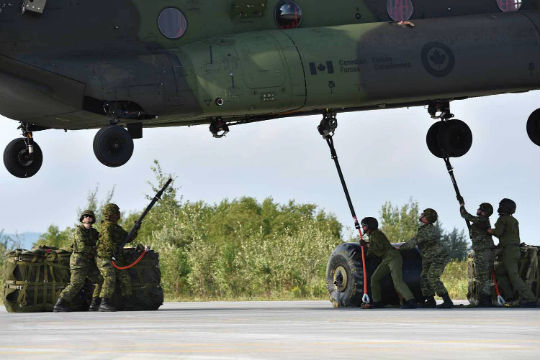
450 Squadron personnel hook up a sling load.
The mission
We had a mission to accomplish, and being on-time and on-target is everything in tactical aviation. We briefed a specific time-on-target, and the Chinook made it easy. A large-scale color terrain chart scrolled across the multi-function display, indicating our progress along our track. The computer knew our route and distance remaining, and obligingly displayed both our current and our required groundspeed.
I flew manually, although the autopilot could have done it. Given the airspeed hold function of the DAFCS in forward flight, and the seemingly infinite thrust in my left hand, tactical flying was reduced to following the terrain with the thrust lever. The Chinook made it feel like I was flying in a straight line and using our downwash to blow the earth out of the way.
Being back in a green helicopter elicited waves of tactical nostalgia, and I elected to follow the contours to enhance terrain masking. I found the Chinook surprisingly agile. Not Ferrari agile, but not Massey Ferguson, either. At Epp’s encouragement, and in the interest of tactical realism, I flew low. Bemused by my novice efforts, Epp took control. He flew lower. 450 Squadron crews are approved to fly down to 25 feet by day. We arrived at our landing spot within seconds of our planned time. The Griffons passed overhead as we landed. We took the enemy completely by surprise. The air force is good at that stuff.
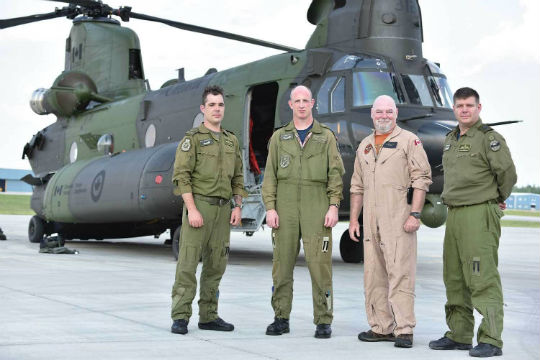
The crew from left to right: MCpl Mike O’Connell, Capt Brian Epp, the author, and MCpl Greg Bullivant.
The return flight to base was initially in formation with the Griffons at 105 knots. Nearing base, Epp hauled on the thrust lever and we bid adieu to the Griffons. The Chinook achieved a 146-knot maximum indicated airspeed, pulling 74 percent torque and burning 3,000 pounds (1,360 kilograms) per hour. For the record, we were cruising at 1,200 feet and it was a +30C day. There was still a considerable reserve of power, but cruising speeds are constrained by a cruise guide indicator (CGI) on the primary flight display, which shows maximum allowable speed in terms of aerodynamic and structural limitations. The ride quality could best be described as “agricultural.” I felt respect for the crews that spend long days in the Chinook. I found the cockpit hot and distressingly loud.
One more task awaited us on return to base: sling loads; a task at which the Chinook excels. 450 Squadron personnel had prepared three roughly 4,000-pound (1,815-kilograms) training loads; a hefty load indeed, so I imagined three lifts. Not the Chinook. We lifted all three of them at once! The three cargo hooks are approved for combined loads of up to 26,000 pounds (11,793 kilograms), although the extensive mission equipment reduces the practical load to “only” 17,000 to 18,000 pounds (7,710 to 8,165 kilograms). Epp again let me try my hand at it. We quickly briefed our expected dual- and single-engine power required, as displayed on the mission computer. Our flight engineer provided voice guidance to situate us over the load, then performed some upside down gymnastics with a shepherd’s hook to grab the lanyards and secure them to our cargo hooks. I flew manually during the hook-up and lift, and the Chinook again made it easy. Our out-of-ground-effect (OGE) power was only 81 percent, with 4,100 pounds (1,860 kilograms) of fuel remaining—and 11,500 pounds (5,215 kilograms) on the hook! Even this didn’t approach the edges of the Chinook’s capability.
Admittedly, in the event of an engine failure, we couldn’t have sustained the OGE hover without dropping the loads, but on departure we were within a safe single-engine regime upon passing through 45 knots. Under sea level, standard conditions, a Chinook will sustain a single-engine OGE hover up to a 36,000-pound (16,330-kilogram) operating weight. In-ground-effect (IGE) hovering on a single-engine is possible up to 40,000 pounds (18,145 kilograms).
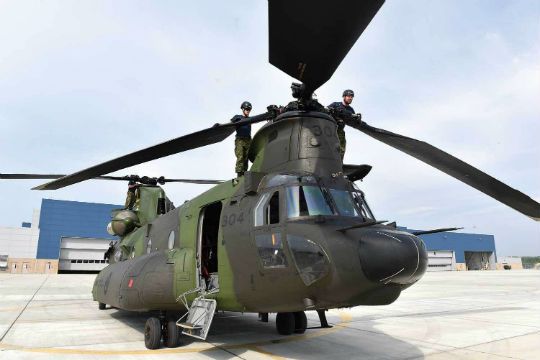
450 Squadron is the sole unit responsible for operating the Chinook.
For reference, the average empty weight of 450 Squadron’s Chinooks is 28,500 pounds (12,925 kilograms). That’s a lot of lift!
The Chinook is impressive not only for its size and performance, but for the range of missions that it can accomplish. Our brief exposure to the Chinook demonstrated a versatile helicopter
capable of moving people or equipment under any conditions.
The newest Canadian Chinooks are poised to provide years of able service to the country’s military both at home and abroad.

A well-dressed Chinook crew, ready for duty.





